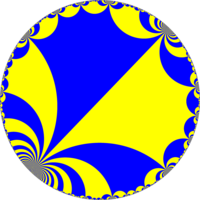| Infinite-order hexagonal tiling | |
|---|---|
 Poincaré disk model of the hyperbolic plane | |
| Type | Hyperbolic regular tiling |
| Vertex configuration | 6∞ |
| Schläfli symbol | {6,∞} |
| Wythoff symbol | ∞ | 6 2 |
| Coxeter diagram | |
| Symmetry group | [∞,6], (*∞62) |
| Dual | Order-6 apeirogonal tiling |
| Properties | Vertex-transitive, edge-transitive, face-transitive |
In 2-dimensional hyperbolic geometry, the infinite-order hexagonal tiling is a regular tiling. It has Schläfli symbol of {6,∞}. All vertices are ideal, located at "infinity", seen on the boundary of the Poincaré hyperbolic disk projection.
YouTube Encyclopedic
-
1/3Views:569 85139 99287 487
-
The complex geometry of Islamic design - Eric Broug
-
How To Draw Geometric Patterns - Moorish Wedge Tiling
-
Lec 15 | MIT 3.091 Introduction to Solid State Chemistry
Transcription
Symmetry
There is a half symmetry form, ![]()
![]()
![]()
![]() , seen with alternating colors:
, seen with alternating colors:
Related polyhedra and tiling
This tiling is topologically related as a part of sequence of regular polyhedra and tilings with vertex figure (6n).
| *n62 symmetry mutation of regular tilings: {6,n} | ||||||||
|---|---|---|---|---|---|---|---|---|
| Spherical | Euclidean | Hyperbolic tilings | ||||||
 {6,2} |
 {6,3} |
 {6,4} |
 {6,5} |
 {6,6} |
 {6,7} |
 {6,8} |
... |  {6,∞} |
See also
References
- John H. Conway; Heidi Burgiel; Chaim Goodman-Strauss (2008). "Chapter 19, The Hyperbolic Archimedean Tessellations". The Symmetries of Things. ISBN 978-1-56881-220-5.
- H. S. M. Coxeter (1999). "Chapter 10: Regular honeycombs in hyperbolic space". The Beauty of Geometry: Twelve Essays. Dover Publications. ISBN 0-486-40919-8. LCCN 99035678.
External links
- Weisstein, Eric W. "Hyperbolic tiling". MathWorld.
- Weisstein, Eric W. "Poincaré hyperbolic disk". MathWorld.
- Hyperbolic and Spherical Tiling Gallery



